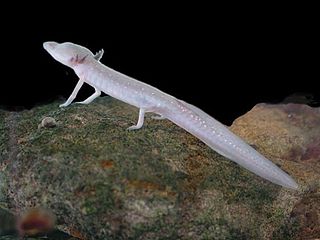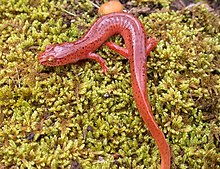
The spotted salamander or yellow-spotted salamander is a mole salamander common in eastern United States and Canada. It is the state amphibian of Ohio and South Carolina. The species ranges from Nova Scotia, to Lake Superior, to southern Georgia and Texas. Its embryos have been found to have symbiotic algae living in and around them, the only known example of vertebrate cells hosting an endosymbiont microbe.

The Texas blind salamander is a rare and endangered cave-dwelling troglobite amphibian native to San Marcos, Hays County, Texas, specifically the San Marcos Pool of the Edwards Aquifer. This species resembles the olm, another stygofaunal salamander from Europe. Unlike the olm, this amphibian's body is not as elongated, and also has less reduced digits on its limbs.

The Cheat Mountain salamander is a species of small woodland salamander in the family Plethodontidae. The species is found only on Cheat Mountain, and a few nearby mountains, in the eastern highlands of West Virginia. It and the West Virginia spring salamander are the only vertebrate species with geographic ranges restricted to that state.

The Pyrenean brook salamander or Pyrenean newt, , is a largely aquatic species of salamander in the family Salamandridae. It is found in the Pyrenees of Andorra, France, and Spain. The IUCN lists it as least concern.

The Oita salamander is a species of salamander in the family Hynobiidae endemic to Japan. Named after Ōita Prefecture, its natural habitats are temperate forests, rivers, intermittent rivers, freshwater marshes, intermittent freshwater marshes, and irrigated land in western Japan. It is threatened by habitat loss, due to the increasing construction of homes within its habitat. The Oita salamander is considered to be vulnerable by the (IUCN) Red List of Threatened Species with a declining population.

The imitator salamander is a species of salamander in the family Plethodontidae. It is endemic to the Appalachian Mountains in the southeastern United States.

The ocoee salamander is a species of salamander in the family Plethodontidae. This salamander has a variety of colors and patterns, and got its name from Tennessee state wildflower. Its natural habitats are temperate forests, rivers, intermittent rivers, freshwater springs and wet rocks in mountainous areas of the Southeastern United States. It was first described by Nicholls in 1949. They are territorial and feed on small invertebrates. It is widely distributed in the southeastern United States and is listed as "Least Concern" by the International Union for Conservation of Nature.

The pygmy salamander is a species of salamander in the family Plethodontidae. It is endemic to the United States in the southern Appalachians in North Carolina and Tennessee. Desmognathus wrighti is a member of the family Plethodontidae and is commonly known as the pygmy salamander. As the name suggest the pygmy salamander is the smallest of the nineteen species in the genus Desmognathus. D. wrighti undergoes direct development and does not have a free-living larval stage. Only two other taxa in Desmognathus, D. aeneus and D. organi, exhibit direct development along with the pygmy salamander. In the genus Desmognathus, body size, habitat preferences, and patterns used by males during courtship are quite variable. D. wrighti courtship is noted by the male biting and seizing its partner in order to provide them with a chemical stimulus. The pygmy salamander can be found in the southern Appalachians of the United States in western North Carolina and eastern Tennessee. Geographical distribution of the Desmognathus wrighti is fragmented and the highest abundance of the species can be found at high elevations in spruce and fir tree forest.

The northern two-lined salamander is a species of salamander in the family Plethodontidae found in Canada and the United States. Its natural habitats are temperate forests, temperate shrubland, rivers, intermittent rivers, freshwater marshes, freshwater springs, arable land, and urban areas. It is more water-oriented than the related northern redback salamander, and can often be found in and around water such as rain puddles, streams, swamps, and damp stream beds, whereas the northern redback tends to be found in damp ground, but usually not near open water.

The Blue Ridge two-lined salamander is a species of salamander in the family Plethodontidae, endemic to the United States. This species is found in the southern Appalachian Mountains, mostly south of Virginia. To the north is a similar salamander, Eurycea bislineata, or the northern two-lined salamander. Its genus, Eurycea contains 33 species and includes taxa that have either a metamorphic life cycle or larval-form paedomorphosis. In species that metamorphose, there can be within-and among-population variation in larval life-history characteristics, e.g., duration of the larval period and size at metamorphosis. Intraspecific geographic variation in species of Eurycea has been attributed to several factors: temperature, stream order and productivity of the larval habitat.

The Berry Cave salamander is a species of salamander in the family Plethodontidae, endemic to the Ridge-and-Valley Appalachians of eastern Tennessee in the United States. Its natural habitat is inland karsts where it lives underground. It is threatened by habitat loss.

The white-spotted slimy salamander is a species of salamander in the family Plethodontidae endemic to the Eastern United States. It is one of 55 species in the genus Plethodon, and was one of the first to be described of its cogeners. The preferred habitat of this species is under logs and leaf litter in shaded hardwood forests and wooded floodplains, and often forages on the forest floor on wet nights. It was found that with increasing temperatures, the aggression in this species also increases. In the plethodon genus, species have a lungless morphology, restricting nearly all gas and water exchange transport to the body surface. This species mainly consumes insects, including ants, centipedes, springtails, crickets, millipedes, slugs, snout-beetles, and earthworms. Common predators of this species are gartersnakes, copperheads, and birds. One of their predator defense mechanisms is the release of noxious/sticky substances through the skin by the dorsal granular glands. Another predator deterrent is when touched, this species will freeze in place and become immobile. This species of Plethodon are mostly terrestrial and deposit their direct-developing eggs on land that omits the aquatic larval stage characteristic of most amphibians, therefore this species is not restricted to aquatic habitats for reproduction and dispersal. This species, along with other Plethodontid salamanders, are frequently parasitized by Trombicula mites.

The red-cheeked salamander, also known as the Jordan's salamander, Jordan's redcheek salamander, or Appalachian woodland salamander, is a species of salamander in the family Plethodontidae. It is endemic to the Appalachian Mountains in the southeastern United States.

The mud salamander is a bright red salamander of the family Plethodontidae. It is found in streams, seeps and swamps and underneath logs, rocks and leaves. It is endemic to the eastern half of the United States with one isolated population in central Mississippi. Mud salamanders are rarely seen plethodontids that inhabit muddy wetland and riparian habitats. Mud salamanders don’t generally live above 700 meters in elevation in the Appalachian Mountains, resulting in two geographically isolated populations. Mud salamanders have short stocky bodies ranging from 7.5 to 16 cm long. Body color ranges with age and locality. There are four subspecies in the mud salamander complex, namely the Gulf Coast mud salamander, rusty mud salamander, Midland mud salamander and the eastern mud salamander. Mud salamanders are ectothermic, meaning that they cannot control their body temperature and it fluctuates with the temperature. The mud salamander is readily confused with two other species, the red salamander and the spring salamander.

The red salamander is a species of salamander in the family (Plethodontidae) endemic to the eastern United States. Its skin is orange/red with random black spots. Its habitats are temperate forests, small creeks, ponds, forests, temperate shrubland, rivers, intermittent rivers, freshwater, trees springs. Overall this species is common and widespread, but locally it has declined because of habitat loss and it is considered threatened in Indiana and New York. Red salamanders eat insects, earthworms, spiders, small crustaceans, snails, and smaller salamanders. To eat, they extend their tongue to capture prey on the tip of it and retract it back into their mouths. The red salamander, as a member of the family Plethodontidae lacks lungs and respires through its skin.

The northern pygmy salamander is a terrestrial species of salamander in the family Plethodontidae and genus Desmognathus. Along with the southern pygmy and the seepage salamander, these are some of the smallest salamander species in North America and can be found in higher elevations in the southern Appalachians.

The Blacksburg salamander is a species of salamander in the family Plethodontidae. It is endemic to the Southeastern United States, where it is restricted to a portion of the Appalachian Mountains in southwestern Virginia. Its common name refers the town of Blacksburg, Virginia, as many specimens were initially found in the vicinity of the town.



















